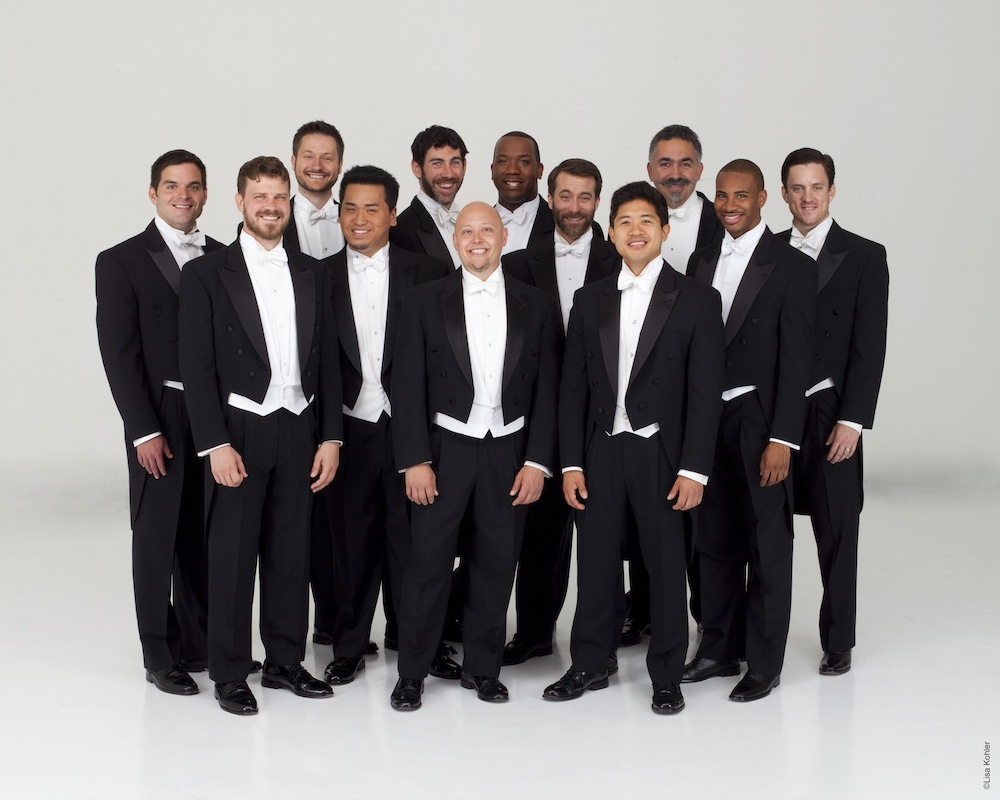Chanticleer roves widely and winningly at Ravinia
The all-male a cappella group Chanticleer kicked off their North American summer tour with an eclectic program at Ravinia’s Martin Theater Sunday night.
The twelve-man ensemble opened the program with liturgical odes to the Virgin Mary—three Renaissance and one pre-Renaissance. The group is clearly at home in this repertoire, leaning into and emphasizing the crunching yet organized dissonances that typify early polyphonic vocal writing. The most haunting moment of this first set of works (all Ravinia premieres, like the majority of the night’s fare) came in Hildegard von Bingen’s Ave Virgo Sanctissima. The male sopranos and altos sang in pitch-perfect unison over a thunderous drone from the ensemble’s basses, creating an eerie, reverential sonority that transported the listener back over a near-millennium.
The program’s other two early music works featured brief madrigals of Claudio Monteverdi and Andrea Gabrielli—uncle of the famous composer of antiphonal brass music. The subject of these two brief works, put plainly, was sex; in the libretto of the former young lovers repeatedly return to life in order to “die again,” and in the latter a similar pair contemplate how many times they will gasp “Oimè.” The ensemble deftly executed these highly complex and contrapuntal works, maintaining constant visual contact with each other and employing subtle cues that amounted to an unobtrusive nod or the raising and lowering of a songbook.
The first half was filled out with composers perhaps more familiar to general concertgoers—the Mendelssohn siblings, Brahms, Ravel, and Barber. Chanticleer was equally at home with this repertoire as with the Renaissance music usually associated with unaccompanied voices. The blend between the different voice types was immaculate, and the fluency with which the group switched from Latin to Italian to German to French to plain American, never losing accuracy of diction, was beyond impressive.
From Fanny Mendelssohn the ensemble offered “Schöne Fremde” from her early Gartenleider—a succinct demonstration of her harmonic and melodic talents. The selection from Fanny’s better-known brother was a setting of Heine’s Wasserfahrt, featured Chanticleer’s basses as a stoical sonic brick wall.
Brahms’ Nachtwache I is a late nostalgic work—one of the a cappella songs from 1889—which Chanticleer imbued with an appropriately haunting atmosphere. Ravel’s Trois Chansons, the composer’s only published foray into choral music, possess a childlike humor (not unlike his Ma Mère l’Oye) and Chanticleer executed them with coquettish grace.
Barber rounded out the first half, in two settings of poems by Emily Dickinson (Let Down the Bars, O Death, and the “Wait” Fantasy), arranged by Chicago composer Steve Hackman. Throughout these works of myriad styles, the group’s blend among different voice types was immaculate as was the fluency with which the group switched from Latin to Italian to German to French to English, while never losing idiomatic pronunciation.
The second half of the performance featured more popular fare—a commission from native Chicago composer Stacy Garrop. Give Me Hunger, a setting of a Carl Sandburg poem, began the second half with driving, percussive vocals, before Chanticleer entered the folk and popular arenas.
From their latest album “Someone New,” featuring arrangements of many popular songs (also by Hackman) they veered from their printed program to sing two moving Joni Mitchell selections before ending the evening with a gospel medley by music director emeritus Joseph Jennings. It was an evening of vocal pyrotechnics that still managed to traverse a wide spectrum of emotional expression.
Posted in Performances





